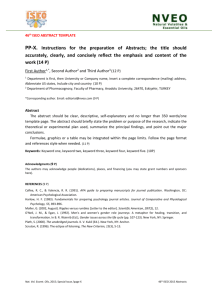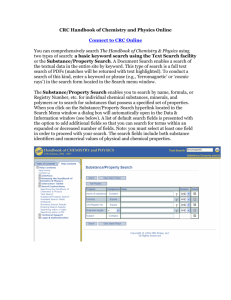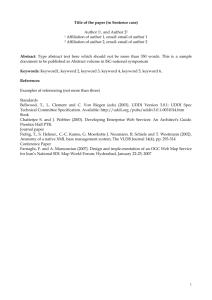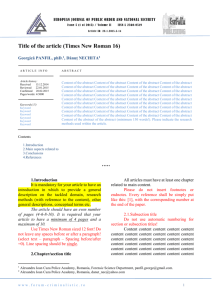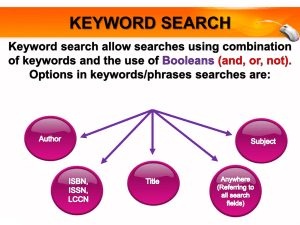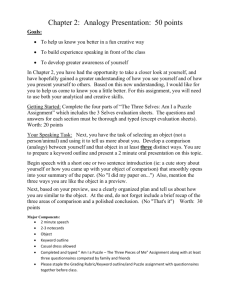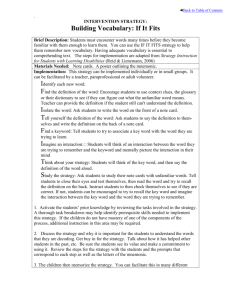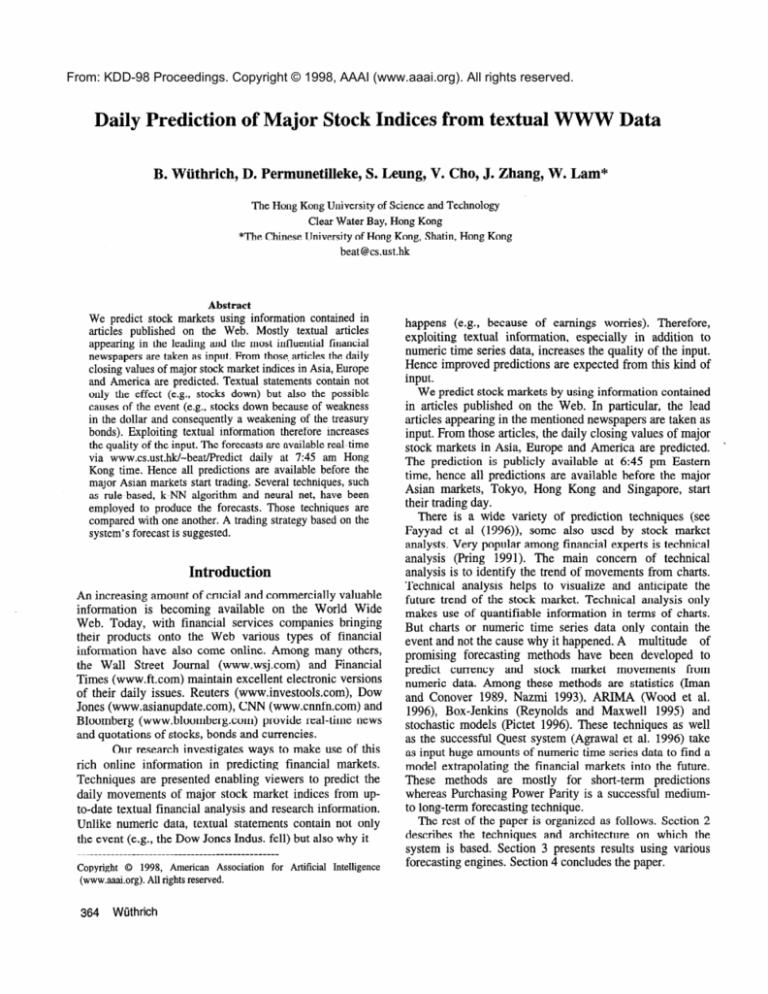
From: KDD-98 Proceedings. Copyright © 1998, AAAI (www.aaai.org). All rights reserved.
Daily Prediction of Major Stock Indices from textual WWW Data
B. Wiithrich, D. Permunetilleke, S. Leung, V. Cho, J. Zhang, W. Lam*
The Hong Kong University of Scienceand Technology
Clear Water Bay, Hong Kong
*The ChineseUniversity of Hong Kong, Shatin,Hong Kong
beat@cs.ust.hk
Abstract
We predict stock markets using information contained in
articles published on the Web. Mostly textual articles
appearing in the leading and the most influential financial
newspapersare taken as input. From those,articles the daily
closing valuesof major stock market indices in Asia, Europe
and America are predicted. Textual statementscontain not
only the effect (e.g., stocks down) but also the possible
causesof the event (e.g., stocks down becauseof weakness
in the dollar and consequentlya weakening of the treasury
bonds). Exploiting textual information therefore increases
the quality of the input. The forecastsare availablereal-time
via www.cs.ust.hk/-beat/Predict daily at 7:45 am Hong
Kong time. Hence all predictions are available before the
major Asian markets start trading. Severaltechniques,such
as rule-based, k-NN algorithm and neural net, have been
employed to produce the forecasts. Those techniques are
comparedwith one another.A trading strategybasedon the
system’sforecastis suggested.
Introduction
An increasing amount of crucial and commercially valuable
information is becoming available on the World Wide
Web. Today, with financial services companies bringing
their products onto the Web various types of financial
information have also come online. Among many others,
the Wall Street Journal (www.wsj.com) and Financial
Times (www.ft.com) maintain excellent electronic versions
of their daily issues. Reuters (www.investools.com), Dow
Jones (www.asianupdate.com), CNN (www.cnnfn.com) and
Bloomberg (www.bloomberg.com) provide real-time news
and quotations of stocks, bonds and currencies.
Our research investigates ways to make use of this
rich online information in predicting financial markets.
Techniques are presented enabling viewers to predict the
daily movements of major stock market indices from upto-date textual financial analysis and research information.
Unlike numeric data, textual statements contain not only
the event (e.g., the Dow Jones Indus. fell) but also why it
__----------_---_-_----------------------------Copyright
0 1998, American
Association
(www.aaai.org). All rights reserved.
364
Wfithrich
for
Artificial
Intelligence
happens (e.g., because of earnings worries). Therefore,
exploiting textual information, especially in addition to
numeric time series data, increases the quality of the input.
Hence improved predictions are expected from this kind of
input.
We predict stock markets by using information contained
in articles published on the Web. In particular, the lead
articles appearing in the mentioned newspapers are taken as
input. From those articles, the daily closing values of major
stock markets in Asia, Europe and America are predicted. ’
The prediction is publicly available at 6:45 pm Eastern
time, hence all predictions are available before the major
Asian markets, Tokyo, Hong Kong and Singapore, start
their trading day.
There is a wide variety of prediction techniques (see
Fayyad et al (1996)), some also used by stock market
analysts. Very popular among financial experts is technical
analysis (Pring 1991). The main concern of technical
analysis is to identify the trend of movements from charts.
Technical analysis helps to visualize and anticipate the
future trend of the stock market. Technical analysis only
makes use of quantifiable information in terms of charts.
But charts or numeric time series data only contain the
event and not the cause why it happened. A multitude of
promising forecasting methods have been developed to
predict currency and stock market movements from
numeric data. Among these methods are statistics (Iman
and Conover 1989, Nazmi 1993), ARIMA (Wood et al.
1996), Box-Jenkins (Reynolds and Maxwell 1995) and
stochastic models (Pictet 1996). These techniques as well
as the successful Quest system (Agrawal et al. 1996) take
as input huge amounts of numeric time series data to find a
model extrapolating the financial markets into the future.
These methods are mostly for short-term predictions
whereas Purchasing Power Parity is a successful mediumto long-term forecasting technique.
The rest of the paper is organized as follows. Section 2
describes the techniques and architecture on which the
system is based. Section 3 presents results using various
forecasting engines. Section 4 concludes the paper.
Prediction Techniques
daily stock market forecast can be followed, see Figure 2.
Our system predicts daily movements of five stock indices:
the Dow Jones Industrial Average (Dow), the Nikkei 225
(Nky), the Financial Times 100 Index (Ftse), the Hang
Seng Index (His), and the Singapore Straits Index (Sti).
Every morning Web pages from www.wsj.com containing
financial analysis and information about what happened on
the world’s stock, currency and bond markets are
downloaded. This most recent news is stored in Today’s
news, see Figure 1. Index value contains the latest closing
values, they are also downloaded by the agent who is active
only on stock trading days.
I Ge
APPIY
Agent
downloading
Web
and
rules
managing
data
Figure 1: architecture and main component of the
prediction system.
In Figure 1, Old news and Old index values contain the
training data, the news and closing values of the last one
hundred stock trading days. Keyword records contains over
four hundred individual sequences of words (those
sequences are the equivalent of phrases in Lent, Agrawal,
and Srikant (1997)) such as “bond strong”, “dollar falter”,
“property weak”, “dow rebound”, “technology rebound
strongly”, etc. These are sequences of words (either pairs,
triples, quadruples or quintuples) provided once by a
domain expert and judged to be influential factors
potentially moving stock markets.
Given the downloaded data described, the prediction is
done as follows:
1, The number of occurrences of the keyword records in the
news of each day is counted.
2. The occurrences of the keywords are then transforrned
into weights (a real number between zero and one). This
way, for each day, each keyword gets a weight.
3. From the weights and the closing values of the training
data, probabilistic rules are generated Wtithrich (1995),
Wtithrich (1997).
4. The generated rules are applied to today’s news. This
predicts whether a particular index such as the Dow will go
up (appreciates at least OS%), moves down (declines at
least 0.5%) or remains steady (changes less than 0.5% from
its previous closing value).
5.From the prediction whether the Dow goes up, down or
remains steady, and from the latest closing value also the
expected actual closing value such as 8393 is predicted.
6. The generated predictions are then moved to the Web
page www.cs.ust.hk/-beat/Predict where each day at 7:45
am local time in Hong Kong (6:45 pm Eastern time) the
Figure 2: index predictions provided daily at 7:45 am
Hong Kong time.
In what follows, we describe the individual steps of this
process. The counting of keyword records is case
insensitive, stemming algorithms are applied and the
system considers not only exact matches. For example, if
we have a keyword record “stock drop”, and a web page
contains a phrase “stocks have really dropped”, the system
does still count this as a match.
In a next step, a weight (i.e. a real number between zero
and one) for each keyword record is computed. Figure 4
depicts this situation.
:
I
Figure 3: weights are generated from keyword record
occurrences.
There is a long history in the text retrieval literature on
using keyword weighting to classify and rank documents.
Keen (1991) and Salton & Buckley (1988) give an
overview on term weighting approaches in automatic text
retrieval. In contrast to these approaches, however, we
consider not a single keyword but pairs, triples, quadruples
or quintuples of keywords. There are many approaches to
conducting term weighting. One commonly used approach
is to use three components: term frequency, document
discrimination, and normalization.
KDD-98
365
Term frequency (TF) is the number of occurrences of a
keyword record in a day’s web pages. Keyword records that
are mentioned frequently are assigned a larger weight.
Term frequency factor alone is not a good indicator of the
strength or importance of a keyword record. This is due to
the fact that if a keyword record appears on each day’s web
pages, the keyword record is not a characteristic for a
particular day.
Therefore, category frequency (CF) is introduced. For
each possible category: stock index up, down, or steady, the
CF of a keyword record is the number of training days
containing the keyword record in that particular category at
least once, see Table 1.
Keyword Record
Hsi up
Hsi down
Hsi steady
Bond lost
13
23
18
Stock mixed
2
31
1
Interest rate cut
20
18
9
CDF:
L
3 CFi,d*wn
9 CFi,.~*eady
Weighted
STOCK-UP(T)
<--STERLING-ADD(T-l),
NOT[TECHNOLOGY-SELL(T-2)]
STOCK-UP(T)
<--YEN-PLUNG(T-1)
STOCK-UP(T)
<--TOKYO-RETREAT(T-2),
NOT PROPERTY-DOWN(T-2)
ti
I
I bond lost
I
1.26
I
Marl6
1
Marl7
1
0.42
1
1.70
1
stock mixed
0.86
0.0
interest rate cut
0.85
1.70
day’s Maximum
1.26
1.70
6.88
2.13
1
1
I
I
Table 2: maximum values used to do normalization.
6.88
The third weighting term is the normalization factor. For
each day, we find the maximum weight of a keyword
record (day’s maximum) and divide the weights for that day
by this maximum. This assures that the final weight is a
real number between zero and one. We tried various other
weighting schemes (see Leung (1997) for more information
on different weighting schemes) but the one described
yields the highest forecasting accuracy.
Once the keyword counts are transformed into weights
three rules sets are generated for each index to forecast, see
366
Wiithrich
closing
<--STOCK-ROSE(T-l),
NOT[NASDAQ-DROP(T-l)],
NOT[PROPERTY-SURGE(T-2)1,
NOT[INTEREST-HIKE(T-2)]
ti
1
index
STOCK-UP(T)
)
where CF,, is the category frequency of a keyword
record i in category c, and is the number of days that the
keyword record i appears. Taking CDF into account assigns
keyword records that concentrate in one category alone a
higher weight. They are calculated by multiplying the term
frequency with category discrimination (TFxCDF). Table
shows such weights.
Marl5
tuples
The rule bodies consist of the keyword records and their
evaluation yields a probability saying how likely the
particular index is going up, down or remains steady. The
following is the sample rule set generated on 6* March
computing how likely the Nky is going to move up today.
=
1
keyword
Figure 4: rules are generated from weighted keywords
and closing values.
Table 1: category frequency of keyword records with
respect to an index.
For example, the keyword record “bond lost” appeared
on twenty three days when the His index went down. Based
on the CF, category discrimination factor (CDF) is
computed:
maxtcFi,q
Figure 5. Wtithrich (1997) describes how such probabilistic
rules (unlike other rule based approaches these rules can
also deal with weights) with conditional probabilities are
generated.
Once these rules are generated, they are applied to the
most recently collected textual news and analysis results.
So the likelihood of the Nky going up on 6” March depends
for instance on the weight computed for s t ock rose
on 5* March, and the of property
surge valid for 4”
March. From those probabilities, i.e. how likely the Nky is
going up, down or remains steady, the final decision is
taken. For example, the final decision is that the Nky
moves up. Though maximum likelihood yields already
good results for making this final decision, we found a
slight improvement over maximum likelihood for this
application (this is described in detail in Cho and Wuthrich
(1998)).
After the direction of the stock market movement is
determined (up, down or steady), the closing value of the
stock index is computed. Suppose the generated rules
expect an upward movement for the next day and the
Tokyo’s major stock index closed yesterday at 16865. The
generated rules are now also applied to the training data
and the average real percentage change x for those days for
which the rules indicate an upward movement is
determined. The forecasted closing value for Nky is
therefore 16865*(1+x) = 17148 (see figure 2).
Performance
The reported performance is achieved in the three months
period, 6” Dee 1997 to 6” March 1998, this includes 60
stock trading days or test cases. As training period serve
always the most recent 100 stock trading days. That is, to
forecast on the 6” March the system is first trained on the
period 5” Dee 97 to 5” March 98. A good yardstick is the
accuracy, i.e. what percentage of the predictions are
correct. For instance, if the system predicts up and the
index moves indeed up then it is correct, otherwise, if the
index is steady or down it is taken as wrong. The accuracy
is shown in the second column of Table 3. The third
column in Table 3 indicates how many times the system
predicts up or down and it was actually steady; or, the
system predicts steady and it was actually up or down. The
last column indicates the percentage of totally wrong
predictions. That is, the system expects the index to go up
and it moves down, or vice versa. It is not surprising that
the results for the Dow and Ftse are the best as most of the
news we download is about these mature markets.
accuracy
slightly
wrong
I
Dow JonesIndus. 1
1
46.7%
1
8.3%
46.7%
36.7 %
16.6%
Nikkei 225
41.7%
38.3 %
20%
1 Hang Seng
I
I SingaporeStraits 1
I
45%
F-l--SE100
average
1
45%
1
26.7%
1
28.3%
1
40%
1
38.3%
1
21.7%
1
43.6%
1
37.4%
1
19%
1
I
Table 3: performance in the period C? Dee 97 to 6”’
March 98.
Table 4 shows the distribution of the actual outcome and
the distribution of the forecast. The judgement of the
predicted numeric value of an index is best done by
comparing the chart of the actual value with the chart of the
predicted value. This can be found on the indicated Web
age.
1 Distr actual outcome (%) I Distr forecast (%)
I
up I steady1 down I
up I steady1 down
Dow
48.3
26.7
25
45
33.3
21.7
Ftse
35
43.3
21.7
51.7
333
15
fi
Avg 1 38.3 1 30.7 1
Table 4: distribution
31 1 37.7 1 30.3 1
32
from 6’h Dee 97 to C?’March 91
Using k-NN learning algorithm (Michie, Spiegelhalter
and Taylor 1994) the best accuracy was achieved by k-NN
with k=9 and the Euclidean similarity measure: Ftse 42%,
Nky 47%, Dow 40%, Hsi 53% and Sti 40%. The test period
was, however, shorter. We also tried forward neural net
work with 423 input nodes, for each keyword one input
node, one layer of 211 hidden nodes and three output nodes
using Back-propagation
training
algorithm.
After
optimizing some parameters, we achieved the following
accuracy on 40 test days in the period 16” Dee to 17* Feb
1998: Hsi 43.9%, Ftse 35.4%, Dow 36.8%, Nky 34.1% and
Sti 32.5%.
We also tried regression analysis on a twenty day
moving average of the closing value of each index. This
method does not yield forty percent accuracy for any of the
indices. Another way to forecast is to just look at the
outcome (up, steady or down) of a particular index over the
n last days and to predict from there the next day. Feed
foreward neural net was used to train on 60 days and n was
varied between 4 to 10. The average accuracy achieved on
forty test days is Dow 36%, His 40%, Fts 42%, Nky 27.5%
and Sti 35%.
In fact, the performance of the system already enables to
construct a simple and money making trading strategy
(Note that one can buy the index in the futures markets;
alternatively, one can buy the largest stocks to simulate the
index as for example the eight largest stocks in Hong Kong
account for over 90% of the Hsi; one can also leverage this
trading strategy by buying in the options market). To keep
the calculation
comprehensible
we make some
assumptions.
Whenever the market goes up it appreciates on average
by 0.5%; when it is steady there is on average 0% change
and when the market goes down it slumps on average by
0.5%. Note that by definition of up (down) the market
appreciates already at least 0.5% (slumps at least 0.5%).
Hence, in reality, markets move on average by much more
than 0.5% when it goes up or down. This pessimistic
assumption is meant to compensate the next assumption
which is to our advantage.
There are no trading costs involved when buying or
selling. Trading costs actually depend on the amount
traded, the specific futures exchange and the brokerage.
When the market opens we can on average buy or sell at
yesterday’s closing price.
We trade as follows.
l
Suppose the system predicts up, we buy when the
opening bell rings and sell when the market is about to
close.
l
Suppose the system predicts steady, we don’t trade.
l
Suppose the system predicts down, we short-sell (selling
without having yet bought) when the opening bell rings and
buy back when the market is about to close.
In summary, after each day we have closed out all
positions, that is, we are neither long nor short on anything.
We can calculate the profit when for instance trading the
Dow Jones Industrial Average during the considered 60
trading days in the period 6* Dee to 6* March. According to
KDD-98
367
table 5 we would have bought on 27 days and short sold on
13 days. Looking at table 4, we would have made 0.5%
profit on 12 days by buying into the market; and we would
have made 0.5% profit by short selling the index on 6 days.
On 19 of the 40 days when we actively traded we would
have been slightly wrong, hence neither a profit nor loss
would have been booked. On the remaining 3 days when
we traded we would have booked a loss of 0.5% as our
system predicted wrongly. Overall, assuming to have bet
each day the same amount of money, the profit is (12+63)* 0.5% or 7.5% over three months. This equals 30%
capital appreciation over one year. In the same period, 6”
Dee to 6” March, the Dow itself appreciated by only 5.1%.
The similar results for the other indices are: trading strategy
for Ftse yields 5.5% (11% actual movement of the index),
Nky 5% (4.3%), His 3.5% (-4.6%), and Sti 4.5% (-8.8).
It is emphasized that the trading strategy also yields
positive returns when the index is actually going down over
the medium to longer term. The performance of the trading
strategy depends on the daily volatility of the markets and
the forecasting accuracy.
Conclusions
We presented techniques and developed facilities for
exploiting textual financial news and analysis results. A
prediction system has been built that uses data mining
techniques and sophisticated keyword record counting and
transformation to produce periodical forecasts of stock
markets. Our techniques take as input textual information
in the form of economic and political news, analysis results
and citations of influential bankers and politicians.
Textual statements contain not only the event (stocks
plummet) but also the possible causes of the event
(weakness in the dollar and consequently a weakening of
the treasury bonds). Exploiting textual information in
addition to numeric time series data increases the quality of
the input. Hence improved predictions are expected. The
real-time
are
via
forecasts
available
www.cs.ust.hW-beat/Predict.
The system can potentially also serve as a decision
support tool to help portfolio managers or traders of options
on futures time the market. For instance, portfolio
managers of mutual funds or institutional pension funds
have to invest millions of dollars over a period as short as
one week. They typically invest an equal amount of money
each day (this is known as dollar cost averaging). However,
if they have a prediction that the stocks are rising and they
may themselves have the hunch that stocks are appreciating
today, then they can try timing the market. On certain days
they would delay their investment (the stocks are expected
to weaken but the market starts steady or strong); whereas
on other days they might invest more and earlier in the day
(when the closing value is expected to be up and the market
starts weak).
There are various directions in which this research can
be extended. First, we do not yet take much numeric time
series data into account. One might consider combining our
368
Wtithrich
techniques with specialized numeric time series forecasters.
Second, as more and more information becomes available
on the Web, other input sources might also be considered
and prove to be of higher quality.
References
Agrawal, R., et al. 1996. The Quest Data Mining System.
Proc. KDD96.
Cho, V. and Wtithrich, B. 1998. Towards Real-time
Discovery from Distributed Information Sources. Proc.
PAKDD 98.
Fayyad, U. M.; Piatetsky-Shapiro G.; Smyth P. and
Uthurusamy R. 1996. Advances in Knowledge Discovery
and Data Mining, AAAI Press / The MIT Press, ~~625.
Hines, W.W. 1990. Probability
and Statistics in
Engineering and Management Science, 3”’edition, Wiley.
Iman, R. L.; and Conover, W. J. 1989. Modern Business
Statistics, Wiley.
Keen, E. M. 1991. Query term weighting schemes for
effective ranked output retrieval. 15th International Online
Information Meeting Proceedings, 135- 142.
Lent, B.; Agrawal, R.; and Srikant, R. 1997. Discovering
Trends in Text Databases, Proc. 31d Znt Conf On
Knowledge Discovery and Data Mining, California.
Leung, S. 1997. Automatic Stock Market Predictions From
World Wide Web Data, Mphil thesis, HKUST.
Michie, D.; Spiegelhalter, D.J. and Taylor, C.C. 1994.
Machine Learning, Neural and Statistical Classification,
Englewood Cliffs, N.J., Prentice Hall.
Nazmi, N. 1993. Forecasting Cyclical Turning Points with
an Index of Leading Indicators: A Probabilistic Approach,
Journal of Forecasting, 12:(3&4), 216-226.
Pictet, O.V. et al., 1996. Genetic Algorithms with
Collective Sharing for Robust Optimization in Financial
Applications, TR Olsen & Assoc Ltd., Zurich.
Pring, M. J. 1991. Technical Analysis Explained, McGrawHill.
Reynolds, S.B. and Maxwell, A. 1995. Box-Jenkins
Forecast Model Identification. AZ Expert, lO(6): 15-28.
Salton, G.; and Buckley, C. 1988. Term-weighting
approaches in automatic text retrieval. Information
Processing and Management, 24:(5)5 13-523.
Wood, D. et al., 1996. Classifying trend movements in the
MSCI USA Capital Market Index - a Comparison of
Regression, ARIMA and Neural Network. Computers &
Operations Research, 23(6):61 l-622.
Wtithrich, B. 1995. Probabilistic Knowledge Bases. IEEE
Transactions of Knowledge and Data Engineering
7(5):691-698.
Wiithrich, B. 1997. Probabilistic Knowledge Bases. ht.
Journal of Intelligent Systems in Accounting Finance and
Management 6~269-277.


